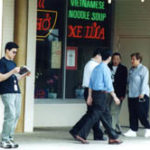By BERNARD CONDON and STEVE ROTHWELL
AP Business Writers
NEW YORK (AP) _ Wall Street has caught a case of the jitters.
Employers are hiring at their fastest pace in 2 1/2 years, the economy is expected to expand by a robust 3.5 percent this quarter and corporate earnings have hit a record. But you wouldn’t know it from the way many investors are acting.
They’re pouring money into U.S. Treasury bonds, considered the world’s safest asset. They’re loading up on dull, but reliable utility stocks. They’re dumping holdings that would get hurt most from a stalled recovery, like stocks of retailers and risky small companies.
Just a few months ago, investors thought the economy would grow rapidly this year. Now they’re not so sure and shifting money around in surprising ways, a sign that confidence remains fragile five years into a recovery.
“It doesn’t take much _ an itsy-bitsy sell-off _ and suddenly everyone is conservative,” says Jim Paulsen, chief investment strategist at Wells Capital Management. “We’ve climbed a wall of worry throughout this recovery and we’re still doing that.”
Many experts had expected a recovery that finally felt like one this year. More companies would be hiring, consumers would spend more, and businesses that had slashed expenses to generate profits would now earn them by selling more. Investors would unload safe government bonds, forcing their prices down and their yields, which move in the opposite direction, up.
But the year is unfolding somewhat off script.
Small-company stocks that are often good bets in an accelerating economy are teetering on a “correction,” Wall Street parlance for a drop of 10 percent from a high. Many Internet stocks, the ultimate optimistic bet, passed that level weeks ago _ and are still dropping. Meanwhile, utilities _ unsexy, but stable _ have soared 10 percent so far this year, more than double the gain of any of the other nine sectors in the Standard & Poor’s 500 index.
Most surprising is the new ardor for U.S. government bonds. Instead of fleeing them as they had late last year, investors can’t seem to buy enough. On Friday, the yield on U.S. Treasury notes maturing in 10 years stood at 2.52 percent, half a percentage point lower that it was just five months. That is a big move for bonds.
There’s plenty of reason for caution _ a stalled housing recovery, for instance, disappointing first-quarter economic growth in the U.S. and Europe, a possible civil war in Ukraine and a cooling Chinese economy. The flood of money into U.S. government bonds may reflect frustration as much as fear. Investors seeking income may be turning to the U.S. because they’re unhappy with the paltry payouts on bonds of other rich countries, such as those of Japan and Germany, where yields are even lower.
But something not as easy to pinpoint, more ephemeral, may also be prompting investors to play it safer: Many Americans, still haunted by the financial crisis, don’t trust the recovery.
“They’re not willing to take risks,” says Matt Lloyd, chief investment strategist of Advisors Asset Management. He points to bankers still too scared to lend, CEOs playing it safe by using cash to buy back stocks instead of expanding operations, and consumers not “buying that fifth TV.”
Jeff Klingelhofer, an associate bond portfolio manager at Thornburg Investment Management, says investors are second-guessing the health of the economy.
“We’ve seen these fits and starts of positive economic (news) only to see a few months later disappointing data,” he says. So investors are taking a wait-and-see approach.
Many economists suspect the U.S. economy shrank in the first three months of the year, but attribute that to harsh winter weather. They are confident of a big expansion in the current quarter.
A raft of recent reports suggests they might be right. Employers added 288,000 jobs in April, the most in 2 1/2 years. Americans have stepped up their spending. And on Thursday, the Labor Department reported that the consumer price index rose a healthy 2 percent in April compared with a year earlier.
Higher inflation can be a sign of economic strength because it usually reflects more spending by shoppers and businesses. But it also is bad for bond investors. The money returned to them when their bond matures will buy less.
But instead of selling U.S. Treasurys, investors bought on the inflation news, pushing the 10-year yield to its lowest in 10 months.
This year’s nervousness follows an exuberant 2013, when the S&P 500-stock index surged nearly 30 percent, not including dividends. By some measures, that has left stocks at dangerous highs compared to earnings, another reason for today’s skittishness.
This year, the S&P 500 has hit ten new highs, two this week alone. But they have been on tiny gains, and the index itself is only 1.6 percent higher than it was at the start of the year. On Friday, after waffling between small gains and losses, the index ended slightly higher.
If this is the top of the market, it feels different from previous peaks.
In 2000, the stock market’s surge was accompanied by books such as “Dow 36,000” which offered tips to profit from a continued climb. The run-up in stocks that ended in 2007 was marked by heavy borrowing by consumers, investors and businesses, with little inkling of the danger ahead.
Today, the mood is sober.
“We don’t sense any excitement,” says Jim Russell, a regional investment director at US Bank. Instead, he says investors are filled with worry “waiting for the next shoe to drop.”











